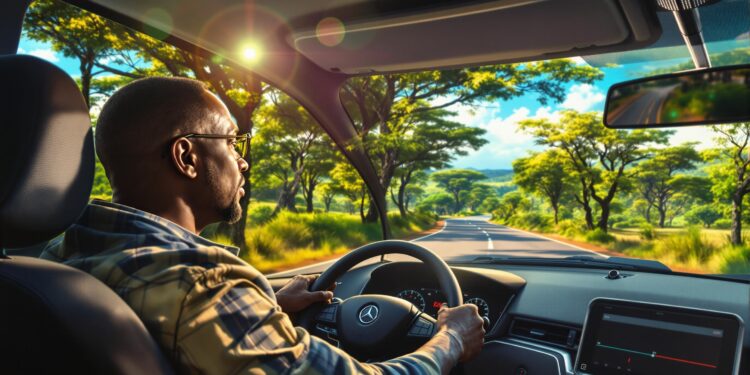Eco-driving in Kenya can save you up to 20% on fuel costs, reduce vehicle wear and tear, and cut emissions by 10-15%. With Kenya’s vehicle numbers rising and fuel efficiency declining, adopting eco-driving practices is more important than ever. Here’s a quick breakdown:
- Key Techniques: Smooth driving, steady speeds, anticipating traffic, reducing idling, and optimizing gear use.
- Maintenance Tips: Regular servicing, tire care, and reducing vehicle weight can boost fuel efficiency by 10-15%.
- Tech Tools: Use apps like Google Maps for eco-routing, fuel monitors for real-time insights, and vehicle features like start-stop systems to save fuel.
- Benefits: Save up to KES 10,000/month, reduce emissions, and strengthen Kenya’s energy security.
Start eco-driving today to save money, protect your car, and contribute to a cleaner Kenya.
Save 20-40% Fuel With PRO Eco-Driving Tips
Key Eco-Driving Techniques
Learning eco-driving techniques can help lower your vehicle’s fuel use and reduce its environmental impact, especially when navigating Kenya’s varied road conditions.
Smooth and Efficient Driving
Driving smoothly plays a big role in saving fuel. Aggressive driving can increase fuel consumption by 15-30% on highways and 10-40% in stop-and-go traffic. A study by Advanced Driving Academy in Kenya found that drivers trained in smooth driving improved their fuel efficiency by 14.8% on their second test circuit [3].
"Smoothness, anticipation, and a little bit of courtesy can get you a long way when it comes to improving your car’s fuel economy." – Shell Kenya
To maximize efficiency, aim to drive between 45-75 km/h, as this speed range is ideal for fuel economy on Kenyan roads. Gradually accelerating from 0 to 60 km/h can save about 11 kilometers’ worth of fuel compared to quick acceleration [4].
Anticipating Traffic and Road Conditions
In busy cities like Nairobi, anticipating traffic patterns helps you maintain steady momentum, saving fuel and avoiding unnecessary stops.
| Driving Behavior | Impact on Fuel Consumption |
|---|---|
| Speed fluctuation (75-85 km/h every 18s) | 20% increase |
| Maintaining steady speed | Up to 15% reduction |
| Aggressive stop-start driving | 30-40% increase |
Keeping a safe distance from the car ahead allows you to brake less often, reducing fuel waste. This is especially helpful in heavy traffic or during peak hours when stop-and-go driving is common.
Reducing Idling and Optimizing Gearing
Letting your car idle for more than 10 seconds uses more fuel than turning it off and restarting. Research shows that idling for just 10 minutes can waste up to 130cc of fuel [4].
For manual transmission vehicles, efficient gear shifting can boost fuel efficiency by up to 10% [1]. Keep engine RPM between 1500-2000 while cruising, shift to higher gears as soon as possible, and downshift when necessary to avoid straining the engine.
Combining these techniques with regular vehicle maintenance can further enhance your efforts to save fuel.
Vehicle Maintenance for Eco-Driving
Keeping your vehicle in good shape is key to saving fuel and cutting emissions on Kenyan roads. According to the Advanced Driving Academy, well-maintained cars can achieve up to 14.8% better fuel efficiency compared to neglected ones [3].
Regular Servicing and Tune-Ups
Routine servicing helps your engine run more efficiently, which means fewer emissions and better performance. Pay attention to these areas to get the most out of your fuel:
- Air filters: Replace every 10,000 km to gain a 3-5% boost in fuel efficiency.
- Spark plugs: Swapping them out every 30,000 km can improve fuel economy by up to 2%.
- Engine oil: Stick to the manufacturer’s schedule for a 1-2% improvement.
"Regular maintenance is key. When you replace worn spark plugs, it allows your engine to run cleaner and optimizes your fuel economy." – Automotive Doctor Motor Garage Limited
Tire Care
Maintaining your tires isn’t just about safety – it also plays a big role in saving fuel. Underinflated tires can make your car work harder, burning more fuel in the process. Proper tire care helps you save on fuel and extends the life of your tires.
Here’s how to keep your tires in check:
- Use a digital gauge to check tire pressure every month.
- Rotate your tires every 6 months or 5,000-7,000 kilometers.
- Get your wheel alignment checked every 8,000-10,000 kilometers.
Reducing Vehicle Weight
Carrying extra weight in your vehicle can cost you at the pump. Trimming down unnecessary items can improve fuel efficiency by about 2% [1]. Here are some simple steps:
- Clear out your trunk of items you don’t need.
- Only carry heavy tools if absolutely necessary.
- Remove roof racks when they’re not in use.
sbb-itb-e5ed0ed
Tools and Technology for Eco-Driving
Modern technology has reshaped eco-driving in Kenya, offering practical ways to boost fuel efficiency and cut emissions. This is especially useful given the country’s traffic jams and older vehicle models.
Fuel Consumption Monitors
Tools like the Fuel Log App and OBD-II Devices let drivers in Kenya keep an eye on fuel usage in real time. They analyze driving habits and offer tips to help save fuel. These insights, accessible through your car or a mobile app, make it easy to adjust your driving style on the spot.
"Using fuel consumption monitors can lead to a reduction of up to 10% in urban driving conditions, according to studies by the International Council on Clean Transportation" [3].
Navigation and Route Planning Apps
Apps like Google Maps and Waze can help drivers in Kenya save fuel by suggesting routes that are more efficient. With real-time traffic updates and features like ‘eco-routing,’ these apps focus on fuel-saving routes rather than just the fastest ones, making them ideal for both city and highway travel.
Eco-Friendly Vehicle Features
Many newer vehicles available in Kenya include features designed to lower fuel consumption:
| Feature | How It Helps | Potential Savings |
|---|---|---|
| Start-Stop System | Turns off the engine when idling | Up to 10% in city driving |
| Eco Mode | Adjusts acceleration and gear shifts | 5-7% improvement |
| Real-time Efficiency Display | Shows fuel usage instantly | 3-5% when actively used |
When used effectively, these built-in tools can cut fuel use by 5-15%, especially in stop-and-go traffic. They give drivers instant feedback, helping them make better choices behind the wheel.
Long-Term Benefits of Eco-Driving in Kenya
Cost Savings
Eco-driving offers substantial savings for both individual drivers and businesses in Kenya. Companies that introduce eco-driving training programs have reported cutting fuel costs by as much as 20%, while individual drivers save up to KES 10,000 each month.
"Two of the most significant costs affecting the bottom line of every transportation company are the amount of fuel used per trip and insurance premiums." – Craig Lyon, TIRF Director, Road Safety Engineering [1]
By adopting eco-driving, drivers can slash monthly fuel bills by up to 20% and trim annual maintenance costs by 10-15%. These savings add up, making it a smart investment. Plus, eco-driving goes beyond just financial perks – it also contributes to a healthier environment in Kenya.
Impact on the Environment
Eco-driving helps cut fuel consumption by up to 15%, which means fewer emissions and cleaner air across Kenya. According to the International Council on Clean Transportation, if eco-driving practices became widespread, greenhouse gas emissions could drop by as much as 10%.
"Eco-driving not only saves money but also helps in reducing our carbon footprint." – Environmental Expert, Kenya [2]
This reduction in emissions supports Kenya’s efforts to decrease dependency on imported fuels and promote environmental sustainability.
Energy Security
Eco-driving plays a role in strengthening energy security by reducing the need for fuel imports. Programs like those run by the Kenya Wildlife Service show how eco-driving can lower fuel usage without compromising efficiency, helping the country retain more foreign exchange reserves.
When paired with regular vehicle maintenance and optimized routing, eco-driving can bring even more benefits. Research from the University of Nairobi highlights that nationwide adoption of these practices could lead to:
- A 10-15% drop in fuel imports
- 174kg less CO2 emitted per vehicle annually
- 5-7% cost savings in the transportation sector
Shell Kenya underscores that properly maintained vehicles driven with eco-driving techniques can make a noticeable dent in the country’s fuel consumption.
Conclusion and Next Steps
Key Points Recap
Eco-driving can lead to noticeable fuel savings for drivers in Kenya – up to 20% immediately after training and around 5% in the long term. Pairing eco-driving techniques with regular vehicle maintenance has proven effective in Kenya’s transport sector, delivering measurable results.
With this in mind, you can take simple steps to start practicing eco-driving today.
Start Eco-Driving Now
Here are some practical actions to help you get started and save fuel:
| Action | Potential Savings | Implementation Timeframe |
|---|---|---|
| Regular maintenance & tire care | Up to 10% fuel savings | Weekly/Monthly checks |
| Smooth acceleration | 11km per 20km/h | Immediate |
| Proper tire pressure | Up to 6% efficiency | Weekly checks |
For more tips and expert advice, websites like AutoMag.co.ke offer helpful tools and resources to keep you on track with eco-driving.
"We see an average of 15-20% in fuel savings for people who learn these efficiency principles." – Conny Eliasson, Kalmar Global Training [1]
Related Blog Posts
- Guide to Electric Vehicle Charging Stations in Kenya
- Ultimate Guide to Off-Road Safety in Kenya
- Ultimate Guide to Car Maintenance Budgeting in Kenya
- Top 5 Brake Care Tips for Kenyan Drivers




